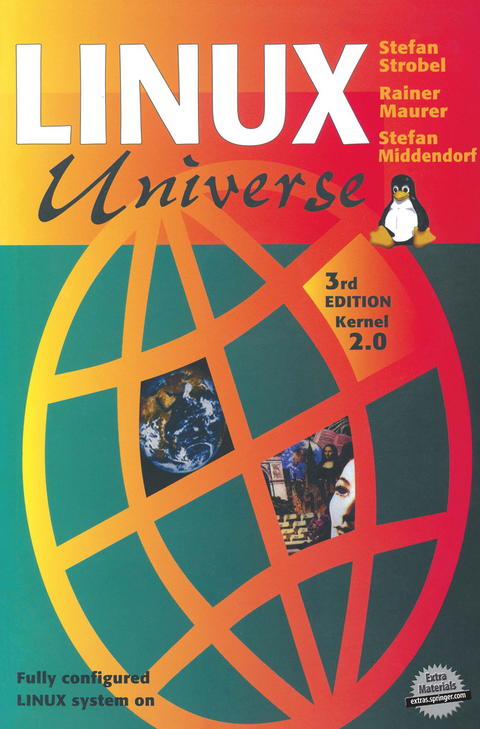
Linux Universe
Springer-Verlag New York Inc.
978-0-387-94879-9 (ISBN)
I ntrod uction or some time 32-bit machines have been a hot topic in the world F ofPCs. It seems that more powerful operating systems will soon be displacing DOS. Meanwhile, at least in the professional literature, lively discussion has been raging about what the future standard will be. Two alternatives seem to be emerging for the domain of server operating systems: Windows NT, and UNIX variants such as UNIX VS. Windows NT Solaris 2, UnixWare, and NextStep 486. In this context OS/2 plays no significant role since it is seen more as a competitor to Windows in its current version and future 32-bit versions. We cannot yet predict which system will finally predominate. However, the significant rise in the power of hardware in recent years has unleashed the demand for a modern operating system that makes use of these developments. Under a modern server operating system, the borderline between classical UNIX workstations and high-end workstations PCs will tend to become more fluid. 1.1 Historical perspectives on Linux An extremely powerful alternative to the above proprietary systems has evolved far from all the big debates on strategy. The system is Linux, a UNIX system for Intel processors that is available for free.
1.1 Historical perspectives on Linux.- 1.2 Versions.- 1.3 Features.- 1.4 UNIX development and standards.- 1.5 The Free Software Foundation.- Features.- New Features in Linux 2.0.- Hardware.- 4.1 Required hardware.- 4.2 Supported hardware.- Basic Installation.- 5.1 Overview.- 5.2 Booting for installation.- 5.3 Partitioning.- The Installation Program.- 6.1 Language.- 6.2 Partitioning.- 6.3 Swap partition.- 6.4 File system partition.- 6.5 X11 configuration.- 6.6 Products.- 6.7 Network adapter selection.- 6.8 Installation.- 6.9 Reboot.- 6.10 Launching a shell.- 6.11 Aborting installation.- The Boot System.- 7.1 Boot options.- 7.2 The Linux Universe boot manager.- 7.3 Boot variants.- Fundamentals of Linux.- 8.1 First things first.- 8.2 Accessing and removing the Linux Universe CD.- 8.3 Accessing other file systems.- 8.4 Linux identifiers.- 8.5 Users and groups.- 8.6 Files under Linux.- 8.7 Essential commands.- 8.8 Redirection of input and output.- 8.9 Piping commands.- 8.10 Accessing floppy disk drives.- 8.11 Virtual consoles.- 8.12 Automatic path extension.- 8.13 Compressed files.- 8.14 Printing.- 8.15 Background commands.- 8.16 Help and documentation.- 8.17 Fundamentals of X11.- Administration.- 9.1 What is administration?.- 9.2 xadmin.- 9.3 Software management.- 9.4 Configuration of the file systems.- 9.5 Setting the keyboard type.- 9.6 Processes.- 9.7 Shutting down the Linux system.- 9.8 Kernel modules.- 9.9 Utilities.- 9.10 The appointment calendar cron.- 9.11 User management.- 9.12 User groups.- 9.13 Adding and removing shells with xadmin.- 9.14 Message of the day.- 9.15 Boot message.- 9.16 Formatting floppy disks.- 9.17 Copying floppy disks.- 9.18 Setting date and time.- 9.19 Backups.- 9.20 Environment variables.- 9.21 Printer configuration.- 9.22 Setting the modem port.- 9.23 Network.- 9.24 Kernel compilation.- 9.25 X11 configuration.- 9.26 Configuration of X applications.- 9.27 The source code CD.- Reference.
| Erscheint lt. Verlag | 16.4.1997 |
|---|---|
| Übersetzer | Robert Bach |
| Zusatzinfo | VIII, 228 p. With online files/update. |
| Verlagsort | New York, NY |
| Sprache | englisch |
| Maße | 155 x 235 mm |
| Themenwelt | Informatik ► Betriebssysteme / Server ► Unix / Linux |
| Mathematik / Informatik ► Informatik ► Netzwerke | |
| Informatik ► Weitere Themen ► Hardware | |
| ISBN-10 | 0-387-94879-1 / 0387948791 |
| ISBN-13 | 978-0-387-94879-9 / 9780387948799 |
| Zustand | Neuware |
| Haben Sie eine Frage zum Produkt? |
aus dem Bereich


